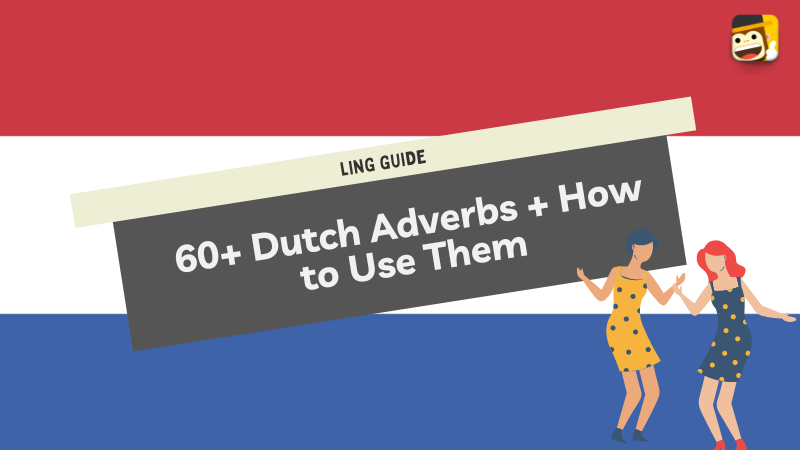In any language, adverbs enlighten sentences with emotion, beauty, and detail. The adverb’s job is to describe verbs, adjectives, or other adverbs. This means that they bring precision and detail into sentences, making language so beautiful and worth learning!
This article focuses on Dutch adverbs, or ‘bijwoorden‘ as they are called in Dutch. English students remember adverbs because they usually end in ‘ly’ (examples: quietly, carefully, calmly, etc).
Though it’s not the same in Dutch, there are similarities in how English and Dutch adverbs are categorized. English and Dutch use adverbs that fall into 5 categories: time, place, frequency, manner, and degree.
In this article, we will look at the placement and formation of Dutch adverbs, how to use them in a sentence, and give you examples of useful Dutch adverbs that native speakers use on a day-to-day basis. Let’s get started!
Want to learn more Dutch grammar? Check out 50+ Useful Dutch Adjectives & How To Use Them to learn about Dutch adjective placement + vocabulary!
Placement Of Dutch Adverbs In A Sentence

Placement #1
Like in English, it’s common in Dutch to place the adverb as close to the verb as possible.
Let’s look at a simple example sentence.
English – I run easily.
Dutch – Ik loop gemakkelijk.
(Easily = gemakkelijk)
As you can see, the adverb ‘easily’ is right after the verb ‘run’ in both languages.
Placement #2
There are many different placements of adverbs in a sentence, depending on type, reason, and subject. For example, if you wish to emphasize the adverb, you can place it at the beginning of the sentence.
In this example, the adverb usually (gewoonlijk) is highlighted at the beginning of the sentence.
English – Usually, I always have plans.
Dutch – Gewoonlijk, heb ik altijd plannen.
Placement #3
The last, most common adverb placement in Dutch is time-manner-place. As the name suggests, adverbs of time come before adverbs of manner, and adverbs of manner come before adverbs of time.
Further in this article, we explain the difference between these types of adverbs and give many examples. But for now, here is an example of a time-manner-place adverb placement in Dutch.
English – Yesterday, I ate happily outside in the garden.
Dutch – Gisteren, at ik gelukkig buiten in de tuin.
Adverb of Time: yesterday (gisteren)
Adverb of Manner: happily (gelukkig)
Adverb of Place: outside (buiten)
There are other more complex placement types, but for now, let’s stick to these three. Now that you know a bit more about the structure of adverbs in Dutch, let’s learn to go through a Dutch vocabulary list.
Five Types Of Dutch Adverbs

Dutch Adverbs Of Time
Adverbs of time tell you when something is happening. This is common in daily interactions, so pay attention because you will frequently use these words in everyday conversations!
| English | Dutch |
| Today | Vandaag |
| Tomorrow | Morgen |
| Yesterday | Gisteren |
| Lately | De laatste tijd |
| This week | Deze week |
| Right now | Nu |
| Tonight | Vanavond |
| Next week | Volgende week |
| Immediately | Meteen |
| Later | Straks |
| Then | Dan |
| Last night | Gisteravond |
| This morning | Vanmorgen |
| Recently | Onlangs |
Dutch Adverbs Of Place
Adverbs of place tell you where something is happening. These words are frequently used in everyday situations, so it’s essential to master them if you want to improve your speaking skills in Dutch.
| English | Dutch |
| Here | Hier |
| There | Daar |
| Everywhere | Overal |
| Outside | Buiten |
| Inside | Binnen |
| Somewhere | Ergens |
| Nowhere | Nergens |
| Over there | Daarginds |
| Far | Veel |
| Home | Thuis |
Dutch Adverbs Of Frequency
Adverbs of frequency tell you how often something happens. They add details that are useful to gauge when speaking to a person about their daily routine, likes and dislikes, and special occasions.
| English | Dutch |
| Never | Nooit |
| Someday | Ooit |
| Rarely | Zelden |
| Usually | Gewoonlijk |
| Often | Vaak |
| Sometimes | Soms |
| Occasionally | Af en toe |
| Almost | Bijna |
| Always | Altijd |
| Regularly | Regelmatig |
| Almost never | Bijna nooit |
Dutch Adverbs Of Manner
Adverbs of manner are descriptor words usually ending in ‘ly’ in English. This is what we think of when we first think of adverbs. They add juice and beauty to sentences to give vivid descriptions and enlighten language.
| English | Dutch |
| Angrily | Kwaad |
| Happily | Gelukkig |
| Beautifully | Mooi |
| Loudly | Luid |
| Fluently | Vlot |
| Easily | Gemakkelijk |
| Badly | Slecht |
| Quite | Nogal |
| Mostly | Merendeels |
| Really | Echt |
| Quickly | Snel |
| Carefully | Voorzichtig |
| Slowly | Langzaam |
| Lovingly | Liefdevol |
| Hardly | Nauwelijks |
| Stupidly | Stom |
Dutch Adverbs Of Degree
Adverbs of degree tell you to what extent something is happening. They are helpful when expressing strong feelings, whether they be good or bad.
| English | Dutch |
| Almost | Bijna |
| Very | Heel/erg |
| Completely | Helemaal |
| Extremely | Zeer |
| Fully | Volledig |
| A lot | Veel |
| Not much | Weinig |
| More or less | Min of meer |
| Hardly | Nauwelijk |
| Absolutely | Absoluut |
| Enough | Genoeg |
| A bit | Een beetje |
| Not enough | Onvoldoende |
Final Thoughts

Adverbs are the underrated carriers of the Dutch language. They are used in almost every sentence and are essential to know if you want to improve your conversational speaking skills.
To recap, there are five types of Dutch adverbs: time, place, frequency, manner, and degree. We looked at three basic adverb placement types.
It would be best if you felt confident in your understanding of the placement of Dutch adverbs. Start practicing Time-Manner-Place adverbs placement, and you’re golden. You’d surprise yourself by how much better you become when learning only 10-15 vocabulary words a day. Confidence plus practice equals success!
Learn Dutch With Ling
Want to learn more Dutch? Download the free Ling App today from the App Store and Play Store. It is a highly researched language-learning app for a fun and personalized experience. With Ling, you’ll smash your Dutch language goals with a little hard work and practice. Aside from Dutch, there are over 60+ foreign languages to learn on Ling. Download it today!
Check out 15+ Easy Ways To Ask How Are You In Dutch & #1 Ultimate Guide To Dutch Verb Tenses to learn more Dutch grammar basics.

















